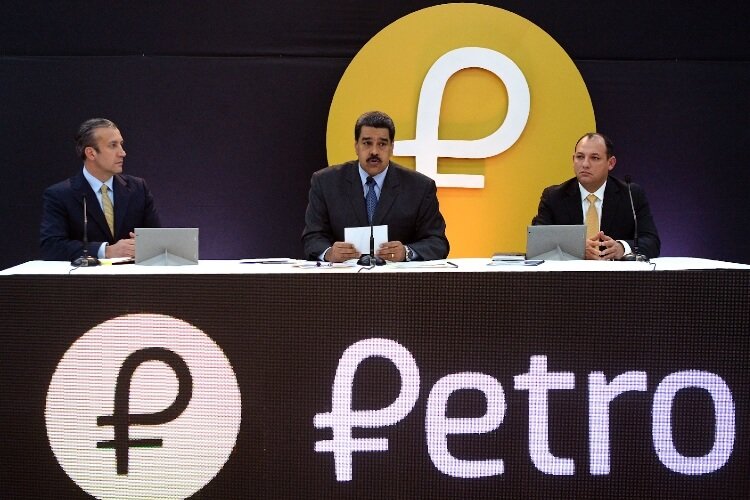Millions of dollars raised by Petro, but still no transactions

Choroni is a small coastal town in the north of Venezuela. The only way to reach it is through a nineteen-twenties' timeworn highway that goes up and down the dense mountains of Henry Pittier's National Park. Founded in 1937, it is Venezuela's first National Park. Choroni has around five thousand inhabitants and it mainly dwells on tourism and fishing. There, the sight of a smartphone is a rare occurrence. I asked a local who worked at a restaurant if he knew anything about bitcoin or crypto. He said some tourist had asked him some days ago if they could pay with bitcoins or Petro. The waiter knew what these are from a government's broadcast on the radio that was flaunting Maduro's soon-to-be place in history for the creation of the "first national cryptocurrency".
Maduro had recently announced that "public entities should make payments in Petros to all officials who are willing to receive the digital currency. It also approved the payment with the cryptocurrency in tourism services, in international service stations and in the consular services of the country". He even said that he wanted gas stations to be able to receive bitcoins and other cryptocurrencies. It would be almost impossible to use bitcoins to pay for gas in Venezuela, where 100 lts of diesel is sold for 100 Bolivares (0.00046$ or 4 satoshis).
"The motive for this crypto-con is to skirt financial sanctions. In the real world if Caracas wanted to sell an ETF it would go to international capital markets. But last year the Trump Administration imposed sanctions that bar banks from transactions with Venezuela’s government and the state-run oil company", — noticed the Wall Street Journal.
This seems to be the widespread assessment around analysts and commentators. This is no surprise given the notorious shadiness that has come to characterize the Maduro's regime attempts at governance. For example, Mr. Maduro has repeated on a number of occasions that each Petro would be backed by an oil barrel. This oil will come from the Ayacucho 1 Field. Mr. Francisco Monaldi, a fellow in Latin American energy policy, outlined some of the reasons why this isn't true:
- The oil in the Ayacucho 1 Field is underground. It isn’t developed and there’s not even a development plan. The required infrastructure, or the piping to transport crude oil, doesn’t exist either.
- 51% or more of the extraction company must be owned by PDVSA (Petróleos de Venezuela) , which is currently in default and doesn’t have funds to invest.
- Out of the theoretical $60 per barrel, the operational profit from extracting the oil would be $5-10 per barrel at most. With that, we must recover the original investment of more than $4 billion per every 100,000 daily barrels produced. Where’s that money coming from?
- Let’s say it [the Petro] gives you the right to invest in the Ayacucho 1 Field, to see your barrel in a decade. How much would you pay for that right without political risk of foul play? How much would you pay in Venezuela, a country where the current Constitution establishes that oil reserves can’t be sold or transferred? A country whose legitimate legislature, recognized by the international community, has declared the Petro an illegal asset.
And indeed, hours after the first sale of the Venezuelan cryptocurrency, the president of the Finance Committee of the National Assembly, Rafael Guzmán, sentenced that "...this currency violates the Constitution because it is very clear that the currency of legal tender in the country is the Bolivar (...). The Government is trying to see if it can get money in the face of the lack of liquidity it has due to the low oil production, which crashed to the floor because of its mismanagement. But they are going to run into a problem: all investors know that it is a fraud". There are several articles in the constitution that specifically dictate the mechanics and rules of the national currency and also how any new debt will be created. He finished by repeating that the Petro was a fraudulent mechanism and an unconstitutional asset.

Mr. Maduro (center) with OFAC sanctioned Vice-President Tareck el-Aissami (left) and Venezuela's Minister of Science, Technology and University Education Hugbel Roa (right)
Mr. Maduro was seen on national television boasting that they had raised an amount of capital that would put the Petro in the top three ICOs valuations ever, above teams backed by deep-pocketed venture capital firms. As of March 2nd, ten days after its “launch”, the NEM blockchain shows that one address controls 100 million Petros (PTR): all Petros are still controlled by one address. This is just one of the many deceptions surrounding Petro. So how exactly did they raise that much money? On promises that they’ll send investors PTR in a few days? Who is that gullible? Well, Petro wasn't really launched on Feb. 20th. In fact, Feb. 23rd the government admitted that it hadn't even developed any smart contracts or issued any tokens yet. Maduro keeps gloating about the 9-digit number: according to his words the “purchase intent” for the Petro is extremely high. But extraordinary claims require extraordinary proof. None of which has been given, making the Petro another example of the lack of transparency that has come to characterize his regime. Mr Machado, a multifarious writer at Caracaschronicles.com thinks that Mr. Maduro’s figure is a manipulative use of the anchoring bias. We can believe with a high degree of certainty that it is just an arbitrary, made up number. Again, this is just one of the many deceptions surrounding Petro. The list goes on and on. Want another example? Maduro will accept Petros at his arbitrary rate and give you back bolívares. Yes, the currency that lost 2,616% of its value in 2017.
Note from the author: Petro is still listed as a scam by ICOIndex.

Mr. Maduro examining a miner